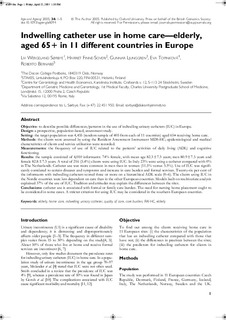Indwelling catheter use in home care - elderly, aged 65+ in 11 different countries in Europe
Journal article, Peer reviewed
Permanent lenke
http://hdl.handle.net/11250/99009Utgivelsesdato
2005Metadata
Vis full innførselSamlinger
- Artikler / Articles [1186]
Sammendrag
Objective: to describe possible differences/patterns in the use of indwelling urinary catheters (IUC) in Europe.
Methods: the clients were assessed by using the Resident Assessment Instrument MDS-HC; epidemiological and medical characteristics of clients and service utilisation were recorded.
Results: the sample consisted of 4,010 informants: 74% female, with mean age 82.3 ± 7.3 years; men 80.9 ± 7.5 years and female 82.8 ± 7.3 years. A total of 216 (5.4%) clients were using IUC. In Italy 23% were using a catheter compared with 0% in The Netherlands. Catheter use was more common in men than in women (11.5% versus 3.3%). Use of IUC was significantly correlated to certain diseases and symptoms and increase in care burden and formal services. Twenty-six per cent of the informants with indwelling catheters scored three or more on a hierarchical ADL scale (0–6). The clients using IUC in the Nordic countries were less dependent on care than in the other European countries. Models built on multivariate analysis explained 37% of the use of IUC. Tradition and attitudes may explain the differences between the sites.
Conclusions: catheter use is associated with formal or family care burden. The need for nursing home placement ought to be considered in some cases. A stricter criterion for using IUC may be considered in the southern European countries.
